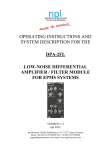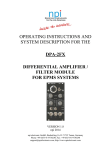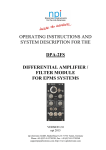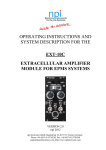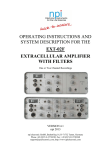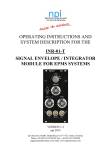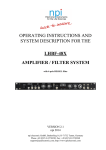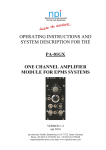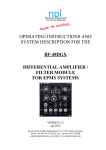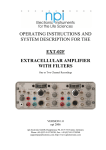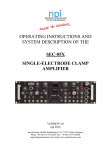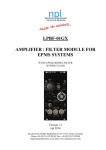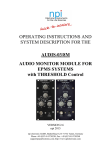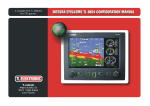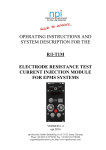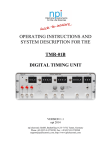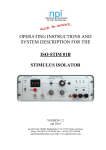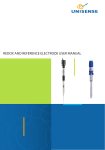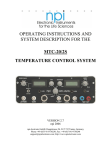Download operating instructions and system description for the ext
Transcript
OPERATING INSTRUCTIONS AND SYSTEM DESCRIPTION FOR THE EXT-10C EXTRACELLULAR AMPLIFIER MODULE FOR EPMS SYSTEMS VERSION 1.5 npi 2005 npi electronic GmbH, Hauptstrasse 96, D-71732 Tamm, Germany Phone +49 (0)7141-601534; Fax: +49 (0)7141-601266 [email protected]; http://www.npielectronic.com EXT-10C User Manual ___________________________________________________________________________ Table of Contents 1. 2. Safety Regulations............................................................................................................ 3 EPMS-07 Modular Plug-In System.................................................................................. 4 2.1. Components of the EPMS-07 Housing ....................................................................... 4 2.2. General System Description / Operation ..................................................................... 4 2.3. System Grounding ....................................................................................................... 5 2.4. Technical Data............................................................................................................. 5 3. EXT-10C .......................................................................................................................... 6 3.1. EXT-10C Components ................................................................................................ 6 3.2. System Description...................................................................................................... 6 3.3. Signal Flow Diagram................................................................................................... 6 3.4. Description of the Front Panel..................................................................................... 7 3.5. Headstage .................................................................................................................... 9 Headstage Elements..................................................................................................... 9 3.6. Operation ..................................................................................................................... 9 4. Literature .......................................................................................................................... 11 5. Technical Data.................................................................................................................. 12 ___________________________________________________________________________ version 1.5 page 2 EXT-10C User Manual ___________________________________________________________________________ 1. Safety Regulations VERY IMPORTANT: Instruments and components supplied by npi electronic are NOT intended for clinical use or medical purposes (e.g. for diagnosis or treatment of humans), or for any other life-supporting system. npi electronic disclaims any warranties for such purpose. Equipment supplied by npi electronic must be operated only by selected, trained and adequately instructed personnel. For details please consult the GENERAL TERMS OF DELIVERY AND CONDITIONS OF BUSINESS of npi electronic, D-71732 Tamm, Germany. 1) GENERAL: This system is designed for use in scientific laboratories and must be operated only by trained staff. General safety regulations for operating electrical devices should be followed. 2) AC MAINS CONNECTION: While working with the npi systems, always adhere to the appropriate safety measures for handling electronic devices. Before using any device please read manuals and instructions carefully. The device is to be operated only at 115/230 Volt 60/50 Hz AC. Please check for appropriate line voltage before connecting any system to mains. Always use a three-wire line cord and a mains power-plug with a protection contact connected to ground (protective earth). Before opening the cabinet, unplug the instrument. Unplug the instrument when replacing the fuse or changing line voltage. Replace fuse only with an appropriate specified type. 3) STATIC ELECTRICITY: Electronic equipment is sensitive to static discharges. Some devices such as sensor inputs are equipped with very sensitive FET amplifiers, which can be damaged by electrostatic charge and must therefore be handled with care. Electrostatic discharge can be avoided by touching a grounded metal surface when changing or adjusting sensors. Always turn power off when adding or removing modules, connecting or disconnecting sensors, headstages or other components from the instrument or 19” cabinet. 4) TEMPERATURE DRIFT / WARM-UP TIME: All analog electronic systems are sensitive to temperature changes. Therefore, all electronic instruments containing analog circuits should be used only in a warmed-up condition (i.e. after internal temperature has reached steady-state values). In most cases a warm-up period of 20-30 minutes is sufficient. 5) HANDLING: Please protect the device from moisture, heat, radiation and corrosive chemicals. ___________________________________________________________________________ version 1.5 page 3 EXT-10C User Manual ___________________________________________________________________________ 2. EPMS-07 Modular Plug-In System 2.1. Components of the EPMS-07 Housing The following items are shipped with the EPMS-07 housing: EPMS-07 cabinet Power cord Fuse 0.8 / 0.4A, slow Front covers 2.2. General System Description / Operation The npi – EPMS-07 is a modular system for processing of bioelectrical signals in electrophysiology (see Figure 1). The system is housed in a 19” rackmount cabinet (3U) containing a power supply and has room for up to 7 plug-in units. The plug-in units are connected to power by a bus at the rear panel. The plug-in units must be kept in position by four screws (M 2,5 x 10). The screws are important not only for mechanical stability but also for proper electrical connection to the system housing. Free area must be protected with covers. In order to avoid induction of electromagnetic noise the power supply unit, the power-switch and the fuse are located at the rear of the housing. Figure 1: Example of a measurement system located in an EPMS housing with two channel iontophoresis and balance module (MVCS-02, MVCC-02), bridge amplifier module (BRAMP-01R) and an extracellular amplifier module (EXT-01C) ___________________________________________________________________________ version 1.5 page 4 EXT-10C User Manual ___________________________________________________________________________ 2.3. System Grounding The 19" cabinet is grounded by the power cable through the ground pin of the mains connector (= protective earth, see chapter 1). In order to avoid ground loops the internal ground is isolated from the protective earth. The internal ground is used on the BNC connectors or GROUND plugs of the modules that are inserted into the EPMS-07 housing. The internal ground and mains ground (= protective earth) can be connected by a wire using the ground plugs on the rear panel of the instrument. It is not possible to predict whether measurements will be less or more noisy with the internal ground and mains ground connected. We recommend that you try both arrangements to determine the best configuration. 2.4. Technical Data - 19” rackmount cabinet, 3U high (1U=1 3/4” = 44.45 mm), for up to 7 plug-in units - Power supply: 115/230 Volts AC, 60/50 Hz, fuse 0.8/0.4 A slow, 45-60 W ___________________________________________________________________________ version 1.5 page 5 EXT-10C User Manual ___________________________________________________________________________ 3. EXT-10C 3.1. EXT-10C Components The following items are shipped with the EXT-10C system: Amplifier module for the EPMS-07 system GND- (2.6 mm banana plug) and REF. (SMB) connectors for headstage Headstage User manual 3.2. System Description The EXT-10C was designed for performing low noise recordings of small extracellular signals in slices or in in vivo preparations using fine tipped glass or metal microelectrodes. The system consists of a module for the npi EPMS-07 modular system and a small headstage with a holding bar. The EXT-10C has a differential input with high input resistance for minimizing noise and the incoming signal can be compensated for offset and capacity of the microelectrode by the two potentiometers OFFSET and C-COMP. An analog balance monitor makes the control of offsets easy. The recorded signal can be obtained either AC with GAIN of 100, 1k or 10k or DC with GAIN of 10, 100 or 1k. An optional NOTCH filter eliminates 50/60 Hz noise. The EXT-10C is designed to be used with the DPA-2F preamplifier/filter module from npi which combines additional gain stages with high- and lowpass filters. 3.3. Signal Flow Diagram The signal is passed through the EXT-10C as shown below. ___________________________________________________________________________ version 1.5 page 6 EXT-10C User Manual ___________________________________________________________________________ 3.4. Description of the Front Panel Figure 2: EXT-10C front panel view In the following description of the front panel elements each element has a number that is related to that in Figure 2. The number is followed by the name (in uppercase letters) written on the front panel and the type of the element (in lowercase letters). Then, a short description of the element is given. (1) HEADSTAGE connector The HEADSTAGE cable is connected to the unit at an 8-pin connector in the center of the module. (2) DC OUTPUT connector BNC connector providing the amplified signal DC coupled. The amplification factor is set by the GAIN DC switch (3). ___________________________________________________________________________ version 1.5 page 7 EXT-10C User Manual ___________________________________________________________________________ (3) GAIN DC switch Switch to set the GAIN of the outgoing DC signal. Three GAIN factors are available: x10, x100 or x1k. (4) C-COMP. potentiometer Control for compensation of stray capacities of the microelectrode (10 turn potentiometer, range 0-20 pF). Due to the positive feedback circuit overcompensation of the capacity will lead to oscillations which may damage the cell. (5) POTENTIAL x10 meter The analog POTENTIAL monitor displays the offset in the range of ±30 mV and is used for optimal cancellation of the OFFSET. (6) –OVER +OVER LEDs LEDs that indicate if the amplifier 10% below it’s positive or negative limit (±10 V). The linear range of the amplifier is ±12 V. (7) OFFSET potentiometer 10 turn potentiometer to compensate for the OFFSET of a DC signal. Note: Position 5 on the OFFSET control corresponds to 0 mV offset. (8) GAIN AC switch Switch to set the GAIN of the outgoing AC signal. Three GAIN factors are available: x100, x1k or x10k. (9) AC OUTPUT connector BNC connector providing the amplified signal AC coupled. The amplification factor is set by switch (8). (10) NOTCH switch (optional) Switch to set the NOTCH filter (50 Hz / 60 Hz) or to bypass the NOTCH filter (switch position OFF). ___________________________________________________________________________ version 1.5 page 8 EXT-10C User Manual ___________________________________________________________________________ 3.5. Headstage Figure 3: electrode holder (optional) and headstage of the EXT-10C Headstage Elements 1 2 3 4 BNC connector for the electrode holder REF: reference electrode connector GND: ground connector holding bar On request, PEL can be implemented using 1 mm or 2 mm banana jacks or using SMC SUBCLIC connectors. 3.6. Operation Extracellular measurements are mostly done in slices or in vivo, where distortions of the signal caused by other instruments and the animal itself are very common. Additionally, extracellular signals are very small and have to be amplified enormously. The drawback is that noise is amplified as well. Therefore, the headstage of the EXT-10C is equipped with a differential input that minimizes noise pick-up. Differential means, that the signal for the amplifier is the difference between the positive (+) (PEL) and negative (-) (REF.) input of the headstage. This results in canceling of all signals which both electrodes record, e.g. noise. For differential measurements, both inputs of the headstage (REF. and PEL) are connected to microelectrodes using cables with grounded enclosure or electrode holders. PEL is connected to the measuring electrode and REF. to the reference electrode. The experimental chamber is grounded by an Ag-AgCl pellet (or an AGAR bridge) connected to GND of the headstage (see Figure 4). If differential measurement is not required (single-ended measurement configuration, see Figure 4), the REF input must be connected to ground (GND). The amplifier is in an undefined state, if the REF is left open, and can go into saturation making reliable measurements impossible. ___________________________________________________________________________ version 1.5 page 9 EXT-10C User Manual ___________________________________________________________________________ Figure 4: headstage connections, A: differential measurement, B: single-ended measurement ___________________________________________________________________________ version 1.5 page 10 EXT-10C User Manual ___________________________________________________________________________ 4. Literature Barmashenko, G., Eysel, U. T., & Mittmann, T. (2003). Changes in intracellular calcium transients and LTP in the surround of visual cortex lesions in rats. Brain Res. 990, 120128. Boulton, A. A., Baker, G. B. & Vanderwolf, C. H. (eds.) (1990). Neurophysiological Techniques, Basic Methods and Concepts. Humana Press, Clifton, New Jersey. Huemmeke, M., Eysel, U. T., & Mittmann, T. (2002). Metabotropic glutamate receptors mediate expression of LTP in slices of rat visual cortex. Eur.J.Neurosci. 15, 1641-1645. Huemmeke, M., Eysel, U. T., & Mittmann, T. (2004). Lesion-induced enhancement of LTP in rat visual cortex is mediated by NMDA receptors containing the NR2B subunit. J Physiol 559 , 875-882. Schulz, D., Huston, J. P., Jezek, K., Haas, H. L., Roth-Harer, A., Selbach, O., & Luhmann, H. J. (2002). Water maze performance, exploratory activity, inhibitory avoidance and hippocampal plasticity in aged superior and inferior learners. Eur.J.Neurosci. 16, 21752185. Kettenmann, H. & Grantyn, R. (eds.) (1992). Practical Electrophysiological Methods. Wiley-Liss, New York Lalley, P.M., A.K. Moschovakis and U. Windhorst (1999) Electrical Activity of Individual Neurons In Situ: Extra- and Intracellular Recording, in: U. Windhorst and H. Johansson (eds.) Modern Techniques in Neuroscience Research, Springer, Berlin, New York Müller, Ch.M. (1992) Extra- and Intracellular Recording in the Slice, in: Kettenmann, H. & Grantyn, R. (eds.) Practical Electro-physiological Methods, Wiley-Liss, New York Ogden, D. (ed.) (1992) Microelectrode Techniques - The Plymouth Workshop Handbook, Second Edition, The Company of Biologists Ltd., Cambridge Seidenbecher, T. and H.C. Pape (2001) Contribution of intralaminar thalamic nuclei to spike-and-wave-discharges during spontaneous seizures in a genetic rat model of absence epilepsy, European Journal of Neuroscience, Vol. 13:1537-1546 Windhorst, U. and H. Johansson (eds.) (1999) Modern Techniques in Neuroscience Research, Springer, Berlin, Heidelberg, New York ___________________________________________________________________________ version 1.5 page 11 EXT-10C User Manual ___________________________________________________________________________ 5. Technical Data Differential Input: CMR >90 dB at 1 kHz (tested with 0 Ω input resistance) Input resistance: >1012 Ω, range ±1 V Output DC: selectable gain (x10, x100, x1k) Output range: ±12 V into 1 kΩ / ±1 V into 50 Ω load Output AC: selectable gain (x100, x1k, x10k) Output range: ±12 V into 1 kΩ / ±1 V into 50 Ω load corner frequency 10 Hz Offset compensation: 10 turn potentiometer, ±100 mV Potential monitor: analog display for the electrode offset, range: ±30 mV Capacity compensation: 0-20 pF, 10 turn potentiometer Size: front panel 12 HP (60.6 mm) x 3U (128,5 mm), 7” (175 mm) deep EPMS-07 SYSTEM Power Requirements: 115/230 V AC, 60/50 Hz, fuse 0.8/0.4 A, slow, 45-60 W (dependent on the modules plugged in) Dimensions: 19” rackmount cabinet, 3U high (1U = 1 3/4” = 44.45 mm) ___________________________________________________________________________ version 1.5 page 12












